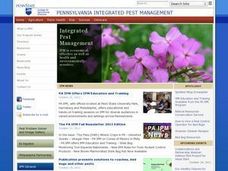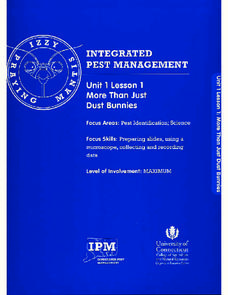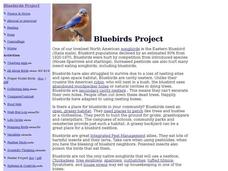Curated OER
Integrated Pest Management
Students investigate the different methods used in integrated pest management. In this biology lesson, students evaluate experiments and case studies on IPM. They discuss the pros and cons of using this method.
Curated OER
Organic Farming / Agriculture
Want an organic farming resource packed with experiments, background information, science fair projects, and topics of interest for further research? Here it is. Young environmental scientists can explore concepts involved in organic...
Cornell University
Let’s Raise Lacewings
Young entomologists explored beneficial insects and how they help control pests in the first lesson of the series. Now class members take a close look at the lacewing, which is a beneficial insect.
Michigan State University
What is IPM?
Learners view a plastic cockroach, mouse, or picture of a pest and discuss if they belong inside the house or school. They discuss what a pest is and brainstorm what makes it a pest and ways to get rid of them. They then discover dangers...
Curated OER
Mouthpart Madness
Students explore the basic biology of a pest. They identify the four major kinds of insect mouthparts and explain how they work. Students examine the specific mouthparts and how they can limit food resources and in what environment an...
Curated OER
Integrated Pest Management-You're Buggin' Me
Students research certain crops and how farmers protect them, while other students research certain insects and how they attack the crop. Each group then documents a ten season plan and then insect and farmers give an attack and...
Curated OER
Bats -- Pests or Pals?
Fourth graders examine a bat and determine if it is a pest or pal. They identify three types of bats native to the state of Pennsylvania. They also identify the parts of a bat and write a report on the bat of their choice.
Curated OER
Duck, Duck, GOOSE!
Students examine the migratory cycle of Canada geese, and explore the reasons that some birds have stopped migrating and become residents of an area. They identify the ways which geese are considered pests and explore ways to control...
Curated OER
What's A Pest?
High schoolers examine the common characteristics of household and lawn pests. They discover the life cycles of the pests. They also learn different ways to control the pests.
Cornell University
Beneficial Insects
A lot of people think of insects as pests. But actually, some insects are beneficial because they get rid of pests! After learning about beneficial insects, class members research given insects to find out if they are pests or predators.
Curated OER
Pest Populations: A Game of Survival
Students identify and classify populations of pests in the home, school and community. They recognize the specific conditions needed for the survival of an organism considered a pest and list tactics for control measures.
University of Connecticut
More Than Just Dust Bunnies
Teenagers will never complain about cleaning their rooms after this activity. In the first lesson of a four-part series, budding scientists collect samples of dust, chalk, and other particulates from various areas of the classroom. They...
Curated OER
Integrated Pest Management
Students compare and contrast the role of the honeybee in nature. They find information by using a variety of resources that could include the internet. Students take part in a paper and pencil formal evaluation with questions that...
Curated OER
Invasion of the Habitat Snatchers!
Fourth graders investigate invasive plants found in a park or school environment and acknowledge the problems caused by the plants. They describe 4 methods of control of invasive plants.
Curated OER
What is a Pest?
Students investigate whether rabbits should be considered pests even though they make good pets. They extend this to determine what, when, and where other organisms are considered to be pests, and examine why the concept of a pest is a...
Curated OER
When Is a Pest an Insect?
Learners view the importance of insects as pollinators. They are now posed with the problem--those insects are nice--but insects are pests right? Students explore their description of pests and pesticides.
Curated OER
Red Means Danger
Students describe some common pests. They study three levels of pest control from the IPM pyramid.
Curated OER
Arthropod Key
Young scholars identify the types of pests and categorize them. They identify their food chain and create a poster showing the food chain for the pests.
Curated OER
Blue birds Project
Students examine the eastern bluebird and acquire knowledge regarding their species and their struggle for survival. In this blue bird project instructional activity, students explore the blue birds' habitat and discover how they are...
Michigan State University
All About Rodents
Get to the know the common house mouse and the Norway rat with an activity that reinforces reading comprehension skills. Scholars read a three-page document detailing key information about mammals, specifically rodents, and use their...
Cornell University
Wasps and Ladybugs
Can a good bug ever become a bad bug? An elementary entomology resource explores what to do when too many ladybugs or too many bees are in your home and can become a problem.
University of Connecticut
Weather Vs. Whether
Monarch butterfly populations have decreased by 90 percent over the past 20 years due to misuse and ineffectiveness of some pesticides. Given the challenge to increase pesticide safety and effectiveness, the class, through discussion,...
Curated OER
IPM Basics
Fourth graders recognize that the term "pest" has a social connotation. They distinguish between good pest management practices and poor pest management practice and demonstrate knowledge of the IPM pyramid.
Curated OER
Web of Life
Students construct a web of life. In this ecosystem lesson students are introduced to ecosystems and life cycles. Insects are the main focus.
Other popular searches
- Integrated Pest Management
- Pest Management Products
- Pest Management Information
- Intergrated Pest Management
- Inter Grated Pest Management

























